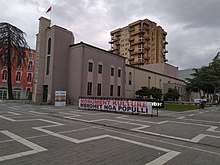National Theatre (Albania)
The National Theatre of Albania (Albanian: Teatri Kombëtar) was the main theatre in Tirana, Albania. In March 2020, the National Theatre of Albania was selected by Europa Nostra among the 7 most endangered monuments in Europe,[1][2] as an exceptional example of modern Italian architecture from the 1930s and one of the most prominent cultural centers in Albania, facing impending threat of demolition.[3] On 17 May 2020, the National Theatre building was demolished.[4]
 | |
%26groups%3D_e2136981555b33fbcace085729b8617f3114cfd2.svg)
| |
| Address | Tirana |
|---|---|
| Coordinates | 41.3265°N 19.8205°E |
| Owner | State owned |
| Construction | |
| Opened | 1939 |
| Demolished | 2020 |
| Website | |
| teatrikombetar | |
History

The National and Experimental Theater Complex was a historical artifact that witnessed many events related to the creation of the Albanian theater, but has also served as the stage for artistic, academic, and political events in post-World War II Albania.
The complex presented various historical layers of interventions that attested to different architectural and engineering styles and approaches of the time. It represented an important stage in the history of urban planning and modern architecture, especially after the long Ottoman period that did not include such concepts of urban planning.
The National Theater building started as the Italian-Albanian Circle named "Circolo Scanderbeg". Until its demolition, it was the first construction of a cultural and sport complex that preserved its cultural function. The materials and techniques applied in this construction were considered innovative for Italy and beyond at European level.
After its opening, the "Savoy" Theater, known in the 1940s as Kino-Theater "Kosova", became the centre, where the most important cultural institutions would be established in post-war Albania. Given these historical facts, this architectural complex was part of the country's cultural and national identity.
The innovative materials — most specifically a material called "Populit" panels, a new material composed of mineralized wood fibers with high strength concrete, was thermally and acoustically insulating.[5] — and techniques applied in this construction were not only for Albania, but were also considered as such for Italy and beyond at European level.
After its opening, the "Savoy" Theater, known in the 1940s as the Theater of Kosovo, after 1945 (at the end of World War II) as "the National" and "National Theater" in modern times, became the center where some of the most important cultural institutions would be established in post-war Albania. Given these historical facts, this architectural complex is part of the country's cultural and national identity.
The interventions of 1950–1954 proved the engagement of some of the most prominent architects after World War II in the country, such as A. Lufi, S. Pashallari, and others. Also, the presence of working groups of Soviet architects like D. Vasiliev shows the impact of Soviet neoclassicism on the increased volume of internal courtyard closure, which remained in good shape until the building's destruction.[5]
Engineers and architects engaged in additional projects and structures (after 1945) and the solutions they apply demonstrate not only their care for the harmonization of the structures of the different phases, but at the same time these interventions prove to us today the political changes in the country by applying techniques and materials different from those of the autarchy period.[5]
The complex was a turning point on the monumental axis, as it is the first rationalist object after a period of neoclassical construction. It is also one of the first rationalist buildings in Albania. The facility was first realized with prefabricated elements and innovative materials at the time, not only in Albania but also beyond. The cultural and sports complex is also the first facility with the pool still existing in the atrium. Scholars classify it as a rationalist building with the influences of Sant Elia and De Chirico's futurism and paintings.[6]
It was later called the Kosovo Movie Theater (Albanian: Kinema Teater Kosova). The inauguration and naming to Professional Theater of the State (Albanian: Teatër Profesionist i Shtetit) occurred on 24 May 1945. Later the theater was called Popular Theater (Albanian: Teatri Popullor). It held that name until June 1991 when it was called 'National Theater'.[7]
Protest and demolition

In 2018, the Albanian government, under Prime Minister Edi Rama, decided to demolish and replace the theater with a new building designed by Bjarke Ingels Group. The National Theatre was relocated to a temporary modern venue named ArTurbina located on Sami Frasheri Street in Tirana.
Plans of the authorities for a new building for the national theater were criticized by artists, professionals and citizens, which led to protests[8] and also the declaration of the historic building as one of the 7 Most Endangered Heritage Sites in Europe by Europa Nostra.[9]
National Theater is considered as one of the most significant monuments of autarchy period in Albania at the beginning of 20th century[2][10][11][12]
Regardless of constant protest by Albanian artists together with the political opposition, the demolition of the National Theatre of Albania started approximately on 4:30 am of the 17th of May 2020. The area was overrun by the State Police as they forcely evacuated every person in the area protesting and detained many artists and high members of the Albanian opposition. Soon after the demolition started, people started gathering in the main boulevard just before the Ministry of Internal Affairs and the National Theatre to protest its demolition. This protest led to numerous other detainments due to the prohibition of gatherings and protests as per COVID-19 restrictions by the Government. [13]
Playwrights
|
|
Theatre Directors
|
|
Actors
- Agim Qirjaqi
- Ahmet Pasha
- Anastas Kristofori
- Andon Qesari
- Bujar Lako
- Antoneta Papapavli
- Besa Imami
- Drita Haxhiraj
- Drita Pelingu
- Edi Luarasi
- Edmond Budina
- Elia Zaharia
- Fatos Haxhiraj
- Ferial Alibali
- Genti Deçka
- Gjon Karma
- Ilia Shyti
- Lazër Filipi
- Lazër Filipi
- Loro Kovaçi
- Luan Qerimi
- Kadri Roshi
- Sandër Prosi
- Margarita Xhepa
- Marie Logoreci
- Ndrek Luca
- Mihal Popi
- Ndriçim Xhepa
- Neritan Liçaj
- Pavlina Mani
- Reshat Arbana
- Robert Ndrenika
- Roland Trebicka
- Roza Anagnosti
- Pjetër Gjoka
- Prokop Mima
- Shkëlqim Basha
- Sulejman Pitarka
- Viktor Gjoka
- Violeta Manushi
- Yllka Mujo
- Laert Vasili
Shows
- Our Land (Albanian: Toka Jonë)
- Hamlet (Albanian: Hamleti)
- The Mayor (Albanian: Prefekti)
- Intrigue and Love (Albanian: Intrigë e Dashuri)
- The Fisher's Family (Albanian: Familja e Peshkatarit)
- The Mountains' Girl (Albanian: Cuca e Maleve)
- A Bridegroom at Fourteen (Albanian: 14 vjec dhender)
- After Death (Albanian: Pas vdekjes)
- The Auditor (Albanian: Revizori)
- King Lear (Albanian: Mbreti Lir)
- Arturo Ui (Albanian: Arturo Ui)
- Korçë's Karnivals (Albanian: Karnavalet e Korçës)
- The Foreign Herth (Albanian: Votra e huej)
- The Fox and the Grapes (Albanian: Dhelpra dhe rrushte)
- Bernarda Alba (Albanian: E Vërteta e Spanjës”(Bernarda Alba))
- The Lady of the Inn (Albanian: Zonja e Bujtinës)
- Artan (Albanian: Artani)
- Everybody's Roof (Albanian: Çatija e të gjithëve)
- The Second Face (Albanian: Fytyra e dytë)
- “Njeriu që pa vdekjen me sy”(Albanian: Pas vdekjes)
- The General of the Dead Army (Albanian: Gjenerali i Ushtrisë së Vdekur)
- The seven people from Shale (Albanian: Shtate Shaljanet)
- The house on the Boulevard (Albanian: Shtëpia në Bulevard)
- The Lady from the City (Albanian: Zonja nga Qyteti)
- On the Trash (Albanian: Mbi Gërmadha)
- The servant of two Sires (Albanian: Shërbëtori i dy zotërinjve)
- The Big Flood (Albanian: Përmbytja e madhe)
Theatres throughout Albania
Albania holds other theatres in Vlora, Durres, Shkoder, Fier, Gjirokastër, Berat and Korce
Kujtim Spahivogli National Experimental Theater of Albania (Albanian: Teatri Kombetar Eksperimental “Kujtim Spahivogli”)
Located in Tirana besides the National Theater, its venues are used by mainly young artists with several successful performances throughout the year.
Children's Theatre (Albanian: Teatri i Kukullave)
The theatre is situated in the center of Tirana. The Albanian name literally means "The Puppet Theatre". The building used to serve as the Albanian parliament before World War II (which was a "puppet parliament" under King Zog).
Another professional Children's theatre is in Korçë, under the A. Z. Çajupi theatre.[14]
See also
References
- "Albanian National Theater among 7 Most Endangered European Heritage Sites". Exit News. Tirana, Albania. March 24, 2020. Retrieved March 25, 2020.
- "National Theatre of Albania, Tirana, ALBANIA". 7mostendangered.eu. March 24, 2020. Retrieved March 25, 2020.
- "Europe's 7 Most Endangered heritage sites 2020 announced". europanostra.org. Europa Nostra. March 24, 2020. Retrieved March 25, 2020.
- . BalkanInside. May 17, 2020 https://balkaninsight.com/2020/05/17/albania-premier-edi-rama-destroys-national-theatre/. Retrieved May 17, 2020. Missing or empty
|title=(help) - Menghini, Anna Bruna (23–25 May 2013). "Experimental building techniques in the 1930's: the "Pater" system in the Ex- Circolo Skanderbeg of Tirana" (PDF). dspace.epoka.edu.al. Retrieved 2020-04-07.
- Gkiosa, Amarilnto (June 27, 2018). "Italian Imperialism in the city of Tirana". Retrieved 2020-04-09 – via Issuu.
- "Teatri nė Shqipėri". Archived from the original on 2009-04-01. Retrieved 2009-12-31.
- Parrock, Jack (12 August 2019). "Protesters occupy Albanian National Theatre in attempt to save historic building". Euronews. Retrieved 2020-04-09.
- "Europe's 7 Most Endangered heritage sites 2020 announced". Europa Nostra. 2020-03-24. Retrieved 2020-04-06.
- "National Theatre of Albania". 109.123.94.27. Retrieved 2020-04-06.
- "Docomomo International". Retrieved 2020-04-06 – via Facebook.
- DOCOMOMO, International (April 6, 2018). "Docomomo International is now appealing to your foremost interest and concern regarding the situation of National Theatre of Albania". docomomo.com. Retrieved 25 April 2020.
- https://exit.al/en/2020/05/17/video-demolition-of-albanias-national-theater/
- Korce Municipality. "Historiku i Teatrit A. Z. Çajupi" [History of the A. Z. Cajupi Theatre] (in Albanian). Archived from the original on 1 August 2012. Retrieved 28 March 2010.